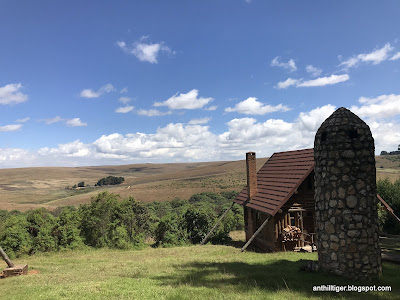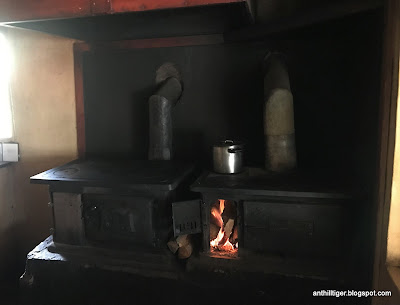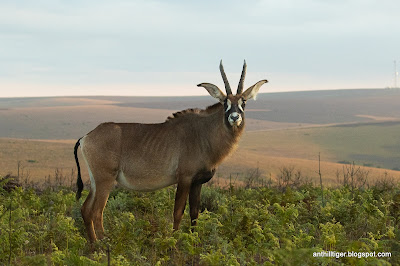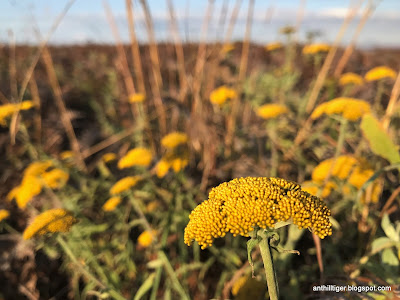 |
| Roan in Nyika NP |
Nyika is not a name that immediately conjures up any distinct images – not like vast open spaces when mentioning the Serengeti or the beautiful palm dotted landscapes when thinking of the Okavango Delta. In fact, I didn’t know anything about the national park nestled in the middle of Malawi, except that it had roan antelope. And that was our primary reason for finally visiting this little-known reserve. But it really delivers so much more and is well worth a visit for hardened safari goers that are looking for something a bit different.
 |
| Nyika NP landscape |
The biggest national park in Malawi and sitting at an
altitude of over 2000m, Nyika is best visited in the dry season, otherwise even
the main roads become impassable, so it was in the middle of winter that we
headed to Nyika. We had timed our visit
while we were in Mzuzu, as it’s only 165km to travel, compared to the 750km
from our home in Blantyre. Still, that
165km is over a 4-hour slog to get to the Nyika Thazima gate.
 |
| Road from Rumphi to the Thazima gate |
Up until about 20km past Rumphi the road is as fine as you can expect on Malawi’s highways, but after that it rapidly deteriorates and once you start climbing towards the Nyika plateau, it’s as if you’re on a wide goat track that hasn’t seen any goats since the last heavy rains.
 |
| The bad roads don't stop the taxis! |
Finally, we arrived at the Nyika gate and 2 very friendly game rangers signed us in and took our payment and gave us an idea of the road ahead because for the first 30km or so, the road is still public as it straddles the Malawi / Zambia border and is a thoroughfare to the northern part of Malawi which leads to the Tanzanian border.
 |
| Forested road that straddles Malawi and Zambia |
At the intersection you turn off from the public road and it was another 30km or so until we got to Chelinda – where the only accommodation in the park was and where we’d be staying for the couple of nights. The ranger told us the 60km or so shouldn’t take much longer than an hour, but we knew better – if a ranger said an hour, we could comfortably double that and probably still be short.
 |
| Look out for the proteas in the forest in Nyika |
And so it was – it actually it took us 3 hours to do the 60km. At first the road is corrugated and winds through an odd forest of stumpy trees and strangely enough proteas. I had thought proteas could only be found in South Africa’s fynbos, but about 10% of the species are found elsewhere, including Nyika NP.
 |
| A view of the Nyika hills |
For most of the time we drove what is essentially the border between Malawi and Zambia and could at first see little houses dotted along the road on the Zambian side before becoming less and less eventually becoming national park on both sides of the road – essentially the Nyika Transfrontier Park that is incorporated into the larger Nyika-North Luangwa Transfrontier Conservation Area.
 |
| Tiny blue wildflowers carpet the landscape |
Along the road on Malawian side is also an electric fence for about 12km – apparently it is a large fenced area where about 100 elephants that were translocated from one of the other national parks a few years ago are being housed as they are still being habituated to Nyika before they are released.
 |
| The dam near Chelinda |
After about 20km it finally opens up and you see the beauty that is Nyika – empty grass covered hills dotted with small patches of evergreen forest in the valleys. It really is a unique and dramatic landscape, unlike anywhere else that we’d been.
 |
| Reedbuck are a common sighting in the hills |
Luckily, the views made up for the lack of game – in fact,
we didn’t see anything except a troupe of wary vervet monkeys until we started
getting closer to the Chelinda area. And
then slowly but surely, we started making out dots on the hills. It took us a while to work it out – reedbuck
in amongst the grasses. For an antelope
we seldom see, there were plenty of them out in Nyika.
 |
| Roan antelope - one of the reasons we'd come to Nyika |
And then we finally got a sighting of what we’d come for – Roan antelope! He was a bit far away, but we photographed him nonetheless, just in case it was the only one we would see for the weekend 😉 Roan are scarce anywhere in Africa and we’d struggled to find them in Southern Africa with only one or two being sighted.
We’d finally found herds of them in Akagera NP, Rwanda but had heard that this was the place to see them and so far it had proved true. And it didn’t take us long to find that the one roan was not alone – it was a herd, but unfortunately too far away for us to get a really good sighting or photos. Still, we were happy that at least we’d seen what we’d hoped for, but hopefully that wasn’t the extent of it!
 |
| Self catering cottages at Chelinda Camp |
Passing some eland along the way (that shockingly didn’t run
off at the sight of us!) we finally pulled into Chelinda camp in the afternoon. Although they do have a campsite, we’d
decided not to camp this time around and rather check out the cottages. There is an upmarket lodge with cabins
reminiscent of Swiss chalets, self-catering cottages for 4-6 people, or just a
self-contained room which we opted for.
 |
| The Swiss style chalets at Chelinda Lodge |
Thanks to Covid, the staff have been reduced from 40 to 10
people, and so all accommodation is self-catering but they do have a chef on
hand to cook your meals with whichever supplies you have brought. We’d decided to braai, but quickly discovered
that they only have one braai stand!
Luckily it was quiet the weekend that we were there, so we quickly
commandeered the braai and the camp manager promised that he would keep it for
us for the next 2 days.
 |
| Inside the communal area at Chelinda camp |
After getting the low down from the camp manager, we got the general layout of the park and where to go from one of the guides. He was really helpful in telling us which roads were closed or to avoid, so soon enough we had a plan on where we wanted to explore for the early evening and see if we could catch some more roan.
 |
| Chosi viewpoint, Nyika NP |
We headed down one of the more popular drives with the with the Chosi viewpoint in mind to get some panoramic views of the landscape. Although the sun was shining creating some beautiful light, it was cloudy and the windchill factor dropped the temperature enough to be lightly freezing 😉
 |
| An LBJ in Nyika |
We didn’t see too much in terms of game on our way to Chosi,
with the highlight spotting a red-winged francolin hiding in the tall grass and
not allowing us any good photos, a posing reedbuck and some zebras grazing on
the rolling grasslands.
 |
| The Malawi-Zambia transfrontier park |
Standing on top of the Chosi viewpoint gives you a fantastic 360° view of Nyika and is well worth a visit, but it was also cold standing up there on top of the hill when no longer protected from the wind by the car, so we were soon heading back down the hill before the sun set and the temperature would really drop!
 |
| Zebra portrait |
Heading back towards the camp, we decided to try and see if
we could find the airstrip as according to the visitor’s book, that was where
they had last seen a leopard and we couldn’t resist chasing after a cat even if
it was a remote possibility and not what we’d come to see. We knew that Nyika had leopards, but
considering how huge the park was and how skittish they would be considering
the lack of regular visitors, we weren’t expecting to see one.
 |
| Rolling hills and reedbuck |
Turns out we couldn’t even find the airstrip 😉 and ended up driving in a different direction, but were rewarded by finding some roan walking down the road and we headed back to camp. In fact, there was a whole herd of them right in the Chelinda camp, so much for driving around looking for them – we should have stayed for sundowners right outside our room! It was a bit too dark to shoot, so we were hoping that they would hang around that night and we’d be able to catch them the next morning instead.
 |
| Brrrrraai time! |
By the time we got into camp, the sun was setting and the temperature was dropping rapidly. Luckily for us the camp attendant had lit a fire for us in the braai stand as well as in our room, so we quickly got a drink and warmed ourselves around the fire before heading to sort out our dinner for the evening.
 |
| Cosy fire in our room |
Wine, plenty of meat and some jacket potatoes later, and we
headed off to our room – luckily kept nice and warm thanks to the fire
crackling away in the fireplace as it was close to freezing outside!
 |
| View from our room |
The next morning we were up before sunrise and a quick breakfast of muesli with coffee before heading out into the fog covered hills. Of course, the roan that had been milling around the camp were nowhere to be seen, so we headed back to the airstrip just in case there were any cats still milling around in the cool air.
 |
| A bright flower amongst the dark grasses |
Unfortunately there were none to be seen although we did see a lot of hyena tracks along the road. Instead, we were treated to a few zebra in early morning light with the hills in the background that still had mist rolling over them.
 |
| Zebra overlooking the mist covered hills |
Deciding to switch tactics, we headed back down the same road as we’d done the previous evening – towards Chosi viewpoint. It seemed the most promising as there were 2 dams along the way and we were quickly rewarded with the roan herd from last night. They were moving away from us, but we decided to move around and try to cut ahead of them.
 |
| A dam in Nyika NP |
We needed to be patient, but eventually some of them headed towards us, including some of the younger members of the herd. It was the biggest herd of roan we’d even come across – a nice breeding herd of adults and plenty of youngsters – obviously Nyika is a stronghold for these beautiful antelope.
 |
| Roan |
After spending quite a bit of time with them without any real closeups of the animals, we moved on to see what else was around. Besides reedbuck we didn’t come across too much else, eventually leading back to one of the dams where we spent an inordinate amount of time trying to identify a bird. It turned out it was a Baglafecht’s weaver, but in a morph that we hadn’t seen before, which explained the difficulty.
 |
| Young roan antelope |
Slowly heading back towards the camp, we came across the
roan again, this time even closer to the road.
But just as they were getting nice and close in the right light, they
all started running away from the road and we soon saw the reason for it – a
ranger and his anti-poaching dog walking up the road. With those 2 on patrol, the roan weren’t
hanging around, so we gave up chasing them and headed back to camp for a good
breakfast.
 |
| Chelinda campsite |
On the way we stopped off at the campsite to check it out
for future visits. The camp ground is
set in a forest of pine trees, but opens in a large open area with a covered
site for each campsite overlooked the rolling hills. With proper ablutions, it looks like a good
site to camp if we were ever back there to camp, although our nice warm
fireplace in our chalet at night would be hard to give up!
 |
| Chelinda campsite setup and view |
We don’t often have a fry up breakfast when in the bush, but this was too good an opportunity to miss – there was a real old-style oven in the camp kitchen which reminded Dru of the old cookers he grew up with, so he quickly commandeered it to serve us up a delicious bacon and egg breakfast, enjoyed outside while overlooking the small lake.
 |
| A good fry up after our morning drive |
Instead of heading back out after breakfast, we decided that we’d take a walk around the area and see if we could catch any birds. The whole camp and lodge are set in a copse of pine trees that were planted when Nyika was still used as a timber plantation. Nowadays there is still planting and harvesting of new pine, but these old pine trees are now protected from felling.
 |
| Old and new pine trees in Nyika NP |
It wasn’t a particularly productive bird walk, not unexpected as we were walking just before midday, but it was nice to meander around the forest and check out the local area, including the exclusive lodge, set up like Swiss chalets overlooking the Nyika hills.
 |
| The old style cooker in the kitchen |
Eventually we headed back in time for lunch – leftovers from the night before with Dru taking to the cooker again to sort it out while I looked to photograph the Giant Kingfisher that was hanging around the lake in front of the camp. Lunch was more successful than my photographic attempts 😉
 |
| A unique landscape of Nyika |
It was a cloudy, but sunny afternoon when we headed out for
our evening drive. It felt like the
clouds would band together and produce a massive thunderstorm, but it never
happened. Instead, it made for stunning
lighting across the unique landscape.
 |
| Roan chilling |
First it was to the airstrip area to see if we could find the zebra that we’d found in the morning. Instead, we found what we’d come to Nyika for – a breeding herd of roan, nice and close to the road and very chilled out. Because they were on the top of a hill, the photos came out quite nicely, with the rolling hills behind them making for some unusual backdrops for the photos.
 |
| Roan closeup |
We spent quite a bit of time with the roan before leaving
them to graze peacefully and took a road we hadn’t driven yet, which led us
down the edge of the old pine plantation. We found some more roan (definitely
the place to visit if you’re looking for them!) and zebra, which an unusual
background of pine trees – not something you see in a national park. Otherwise, with the exception of an Augur
buzzard, we didn’t see much else although we did spot our first warthog for the
trip!
 |
| So many roans! |
We headed further afield this time around and went to check
out Kaulime Dam, about 10km from the camp.
A stunning little waterhole with lovely trees surrounding it, but
unfortunately without much fauna to watch, so we headed back towards the dams,
where the bulk of the animals seemed to congregate.
 |
| Kaulime Dam |
The sky had darkened to the point that it seemed a massive
thunderstorm was imminent, but there still wasn’t any rain, just the light
making the rolling yellow hills absolutely spectacular. We came across some more zebra and roan on
the hills and tried to capture (with varying degrees of success) the beauty of
both the terrain and the skies.
 |
| Darkened skies make for dramatic landscapes |
We also managed to come across a herd of eland. Mostly, we usually spot eland when they are
already running away from us. For the
biggest antelope in Africa, they sure are skittish. But this herd was relatively calm and
although they didn’t let us get too close, they did allow us some photos before
they decided they’d had enough and then all we could shoot was their backsides
as they walked away from us.
 |
| A roan herd in evening light |
We had an alternative reason why we wanted to hang around in
the area that we were headed to – hyenas.
One of the guides had told us that there was a hyena den that could be
seen from the road between the two main dams albeit far away on the opposite
hill face.
 |
| Zebras in front of old pine growth |
The guide said that it was in a clearing just past the 2nd dam and it took us all of 5 seconds to find it – a large clearing on the other side of the valley – exactly where we would have set up a den if we were hyenas 😉
 |
| The hyena den in the middle of a hillside |
Unfortunately, it was so far away that even
with binoculars it was a difficult sighting, but we were rewarded with a few
black blobs – hyena pups! There were
about 3 of them, playing outside the den overseen by an adult hyena. We couldn’t see much more than just the
shapes, but we were quite happy that we’d finally seen a predator in Nyika.
 |
| Eland in Nyika are pretty relaxed |
We were also lucky that a roan herd, probably the same one
as yesterday that had encountered the patrol dog, were grazing in the same area
we’d stopped to watch the hyenas, so we spent a peaceful half hour watching the
roan close by and the hyenas far away as the sun started to dip towards the
horizon.
 |
| Zebras keep a close eye on us |
By now it was getting really cold and we slowly started heading back to camp with the thought to maybe catch the sun setting from the camp in front of the fire that they’d hopefully started already.
 |
| Roan with his whole face in the water to eat the underwater grasses |
We were a bit
delayed when we caught sight of a roan standing in the water eating grasses
that were growing in the water and so he had to put his whole head into the
water to grab hold of the food – we thought it most unusual, but the camp
manager later confirmed to us that they do this quite often – it’s a most
amusing sight!
 |
| Roan in the setting sun |
Back at camp and gratefully in front of the fire that the
camp attendant had already lit, we warmed up with a drink before starting our
evening braai while listening to the sounds of a nightjar. Judging by the call, it was a Rwenzori
nightjar, but since we didn’t actually see it flying around, we couldn’t
positively identify it.
 |
| Chelinda Lodge nestled in the grove of old pine trees |
Another good, yet really cold braai, and we finished our last night at Nyika with a delicious liqueur in front of our toast warm fire before getting to bed to have an early start the next morning. It was to be a long drive as we needed to get to Kasungu by nightfall.
 |
| Through the pine forests |
And so it was – up at 5am to pack, have a quick breakfast and coffee and we were off just after 6am towards the gate. We had decided not to do a game drive, hoping rather that we’d catch some game on the main road out of the park.
 |
| On the way out of Nyika |
Unfortunately, we didn’t see much except a
few reedbuck and then soon it was just a long bumpy road back to the Thazima
gate and then a further 6 hours until we reached Kasungu – a nice long 10 hour
trip!
 |
| Wildflowers |
It is a long drive from Mzuzu to Nyika and then to Kasungu
just to spend a weekend in Nyika, but in our mind it was well worth it. We’d actually have liked to spend at least an
extra day in the park, but circumstances didn’t allow.
 |
| Watching us closely |
Overall, we’re really happy that we made it up there. It’s a truly unique park, unlike any park we’ve experienced in Africa with it’s rolling hills more reminiscent of the English moors, but with little valleys of forests and of course big antelope that remind you that you’re on the African continent. Nyika is well worth a visit if you’re traveling in Malawi, even if the road to get there leaves a lot to be desired!
 |
| Plenty of proteas! |

No comments:
Post a Comment